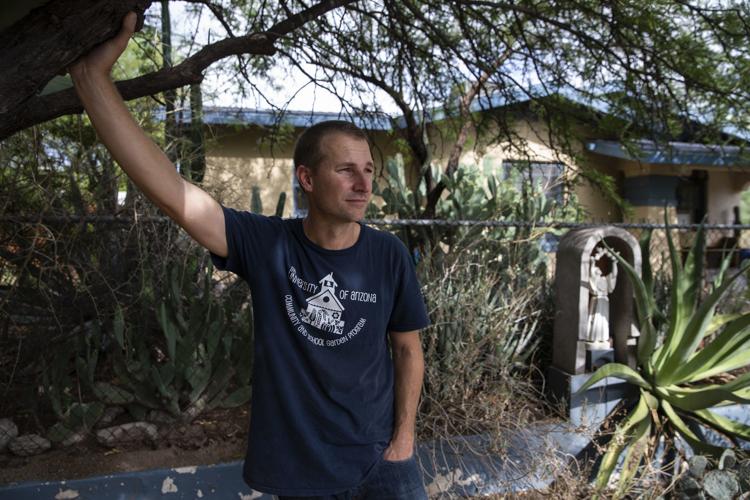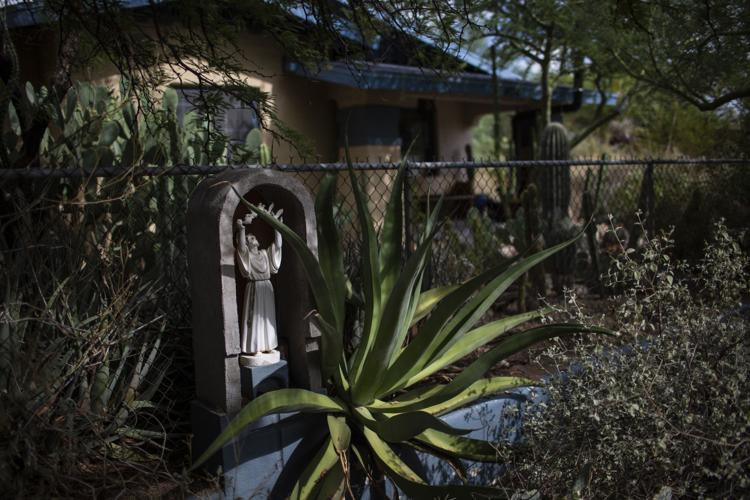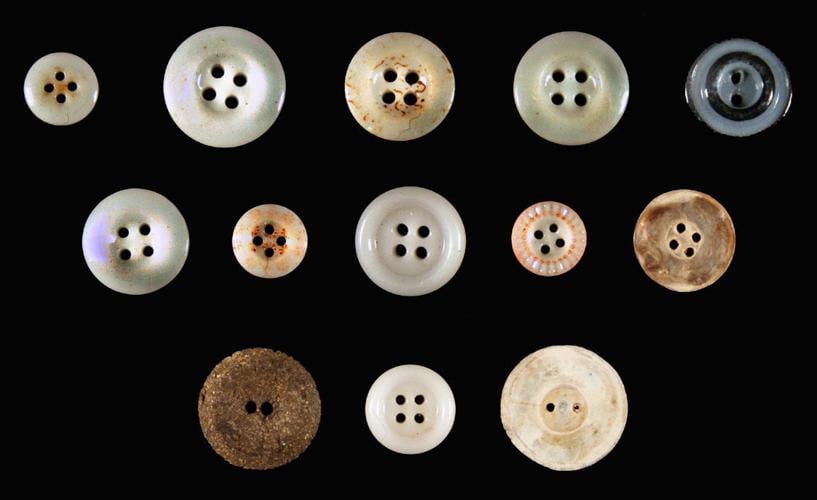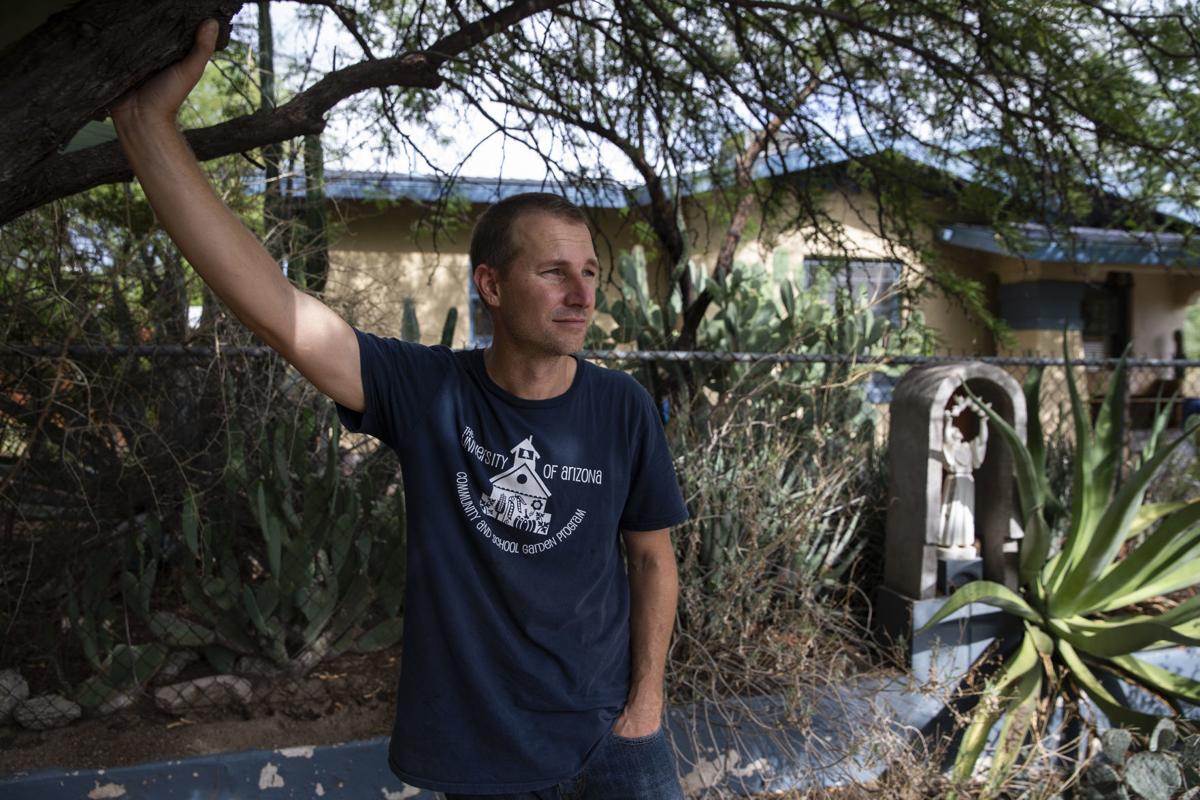Editor's note: This story was originally published in 2019.
Not long after Moses and Kelly Thompson moved into the historic Dunbar Neighborhood, a sinkhole opened up in front of their house on Perry Avenue, north of downtown.
Thompson thought it was a broken sewer line, so he got a shovel and started to dig. He soon struck wood and something underneath.
“I reached in and pulled out a handful of bones,” he said.
That’s how the Thompsons found out they were living on top of one of Tucson’s earliest graveyards.
As many as 9,000 people were buried at the Court Street Cemetery, which opened in 1875 and closed in 1909.
Seven years later, the first homes were built on the graveyard, which covered eight city blocks from Second Street to Speedway and from Main to Stone.
Many of the bodies were never moved.
“Since 1949, about 50 burials have been found,” said Homer Thiel, a research archaeologist from the consulting firm Desert Archaeology.
“In the Catholic half of the cemetery, which is the most crowded half, the average house has somewhere between 80 and a hundred graves on the lot — underneath your house, underneath the sidewalk, in your backyard.
“Probably if you live there, you don’t want to go digging around too much, because you’re going to end up finding somebody.”

This 2006 photo shows one of 54 headstones moved from the old Court Street Cemetery (southwest corner of North Stone and West Speedway) at the turn of the century to the western edge of Evergreen Cemetery.
Child’s coffin stuffed with clothes
Thiel knows more about the Court Street Cemetery than just about anyone alive. He has dug up or identified 25 old graves in the neighborhood, including the one in front of the Thompsons’ house on Perry Avenue.
He said the bones that Thompson found belonged to a Hispanic child, between the ages of 2 and 4, whose gender could not be determined but whose tiny casket also contained an assortment of buttons.
Directly beneath the child, Thiel and his colleague, Susan Hall, discovered the remains of a Hispanic man in his 30s in a matching, adult-sized coffin, suggesting the two were buried together.
It’s unclear what killed them, but the evidence points to a communicable disease such as smallpox or cholera.
People were rarely buried with their personal effects back then, Thiel said, but the child’s coffin was stuffed with clothing and the man still had a comb, a pocketknife, a change purse and some coins in his pockets, perhaps out of fear of contagion.
Thompson said he took time off from work to watch the archaeologists sift through the grave in his front yard. “It was fascinating,” he said.
A few weeks after the bodies were removed, Thompson marked the spot with a small shrine featuring a statue of St. Francis, the patron saint of families and against dying alone, among other things.
That’s the thing about living on top of an abandoned cemetery, he said: It isn’t spooky; it’s sad.
“These people were somebody’s family. They probably meant the world to somebody,” Thompson said. “It sucks that they were left in the ground do be found with a shovel by someone like me.”

A shrine is dedicated to two graves that were found in front of Moses Thompson’s home in Tucson’s Dunbar Neighborhood.
in Tucson.
Many bodies were never moved
Thiel expects more skeletons to turn up.
He excavated his first grave in the Dunbar Neighborhood in 2005. Since then, he has been compiling a database with as much information as he can find about anyone who was buried in the old cemetery.
His list so far includes about 5,000 names, mostly combed from death certificates, Catholic burial records, probate court documents and late-19th century obituary notices printed in the Arizona Daily Star.
Court Street was Tucson’s third community burial ground, replacing National Cemetery, which operated until 1881 where the Pima County Courthouse now stands.
National took the place of the original Presidio Cemetery, which operated until the 1850s where the old county courthouse was eventually built.
Thiel said Court Street’s fate was sealed in 1907, when a group of businessmen convinced the city council to start using their new Evergreen cemetery instead.
The owners even offered to move the bodies from the old burial ground for $50 each, “so they were going to make money one way or another,” he said.
Many early Tucson residents couldn’t afford the relocation fee. Those who could may have been cheated out of their money, Thiel said.
“There are rows of tombstones in Evergreen where it’s not clear whether the bodies were actually moved. They might have just done the ‘Poltergeist’ thing and picked up the tombstones and left the bodies behind,” he said.
“As far as I can tell, between 40 and 50% of the bodies were left in place. Either they didn’t know they were there or they just didn’t care.”
Even when they did move a body, they weren’t always careful to collect it all. “They basically reached in and grabbed the big stuff,” Thiel said, leaving behind smaller bones, articles of clothing and, in all but one or two cases, the coffins themselves.

This assortment of buttons was collected from the grave of an unknown child discovered in 2007. The remains of a Hispanic man in his 30s were found directly beneath the child.
Decorative markers
Dunbar went on to become one of Tucson’s first predominately black neighborhoods. The Dunbar School at Main and Second, just outside the cemetery’s boundaries, was a segregated, all-black school until it was integrated and renamed in 1951.
Two churches, a Salvation Army homeless shelter, a hotel, an apartment complex and more than 80 homes now sit on top of the old burial ground.
The only outward signs of the neighborhood’s hallowed past are the shrine in front of the Thompsons’ house and some decorative markers in the median at First Street and 11th Avenue.
Pastor Jonathan Smith leads the Tucson Sharon Seventh-day Adventist Church, a historically black ministry that opened in 1945 at First and 10th. He’d never heard about the cemetery before, but the news didn’t seem to bother him.
He laughed when he found out the church was built on the Protestant side of the burial ground, not the Catholic side.
Smith said he plans to talk about the cemetery during an upcoming sermon. Tucson Sharon is largely a “commuter church” these days, he said, so he doubts whether his congregants know about the graves beneath their feet.
“It reinforces the fact that where we are is sacred ground,” Smith said.

Coffin decorations recovered from a discovered grave. Archaeologists study bones excavated from the site, as well as clothing and the coffin’s wood and other hardware.
Living above the dead is not a deal-breaker
Real estate agent Patty Sue Anderson lives in the Dunbar Neighborhood and has sold a number of houses there over the years.
She said she tells all of her buyers and sellers about the old cemetery, though most homeowners already know about it.
Anderson said she has never had anyone back out of buying a property after finding out there might be bodies buried under it, but she has gotten some intense reactions from people during open houses in the neighborhood.
“I don’t get any offers from people who are queasy about it,” she said.
No one told Mike and Donna Erickson about the cemetery when they bought their historic house on Second Street in 1997.
Their first clue came in 2012, when workers were replacing the sewer line beneath the street and Donna spotted them using the kind of tent medical examiners put up when a dead body is found somewhere. “I watch a lot of cop shows,” she explained.
At first, she was disturbed by the thought of all those forgotten graves. She worried that her friends wouldn’t want to come to her house anymore, once they found out what was underneath it.
Now she just thinks of it as an interesting part of living someplace historic — a Southwestern version of the skull-lined Catacombs of Paris.
“The whole world is built on top of everybody else. It’s part of history,” Erickson said, adding with a laugh, “I guess we’ll be ground zero for the zombie apocalypse.”
“You want to treat them with care”
Thiel and company served as the on-site archaeology monitors for the Second Street sewer project in 2012.
Seven burials from the Catholic portion of the cemetery were discovered during the work, including a woman still clutching rosary beads in her hands.
Each time a grave was found, the sewer work would stop so the archaeologists could carefully excavate the site.
“The number one reason is to prevent the human remains and associated artifacts from being damaged further or destroyed. You want to treat them with care and respect,” Thiel said.
Researchers can also use what they find to learn more about life and death in territorial Tucson, from local burial customs to the most common ways people died.
The process generally works like this: Once a grave is excavated, the bones are sent to the University of Arizona for analysis to determine, when possible, the departed’s age, sex and cause of death — all without using DNA sampling or other destructive tests that are prohibited by state laws protecting historical remains.
Experts at Desert Archaeology then process the rest of the grave, identifying clothing and the wood from the coffin.
Thiel sends photos of the casket handles and decorations to a coffin hardware expert in Shreveport, Louisiana, who traces them back to their manufacturers using old funeral-home catalogs.
Once all the examinations are complete, the bones and other items from the grave are turned over to the Arizona State Museum, which has legal jurisdiction over such things.
In most cases, the remains are eventually reburied based on what is known about the person.
Last year, several bodies from the Catholic section of the Court Street Cemetery —including the man and child from the sinkhole on Perry Avenue — were laid to rest once again, this time at Holy Hope Cemetery on North Oracle Road.
Life goes on in the shadow of death
A lot of life has happened to Moses Thompson in the 12 years since he made his grim discovery.
The tiny agave he planted next to the shrine he built has grown to almost envelop St. Francis. A nearby mesquite that shades the old grave site now features a tree house.
Thompson said he used to light candles for the man and the child on All Souls’ Day, but he hasn’t done that for a few years now.
He doesn’t even think about them all that much anymore, he said, and he thinks he knows why: Thompson didn’t have any kids of his own when he found the bodies buried in his front yard.
Now he has a 2-year-old and a 4-year-old, “right in the same time frame” as that poor, forgotten child, he said.
“If I thought about it too much, I’d probably cry.”

Two coins and a comb were found in the pockets of a man whose grave was unearthed. People were rarely buried with personal effects back then, a research archaeologist says.

Homer Thiel sends photos of casket handles and decorations to a coffin hardware expert in Shreveport, Louisiana, who traces their manufacturers using funeral-home catalogs.











